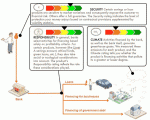 I’ve got a bit of a height thing. When I’m more than eight feet above the ground I start to feel all a bit funny inside, as though I shouldn’t really be there.
I’ve got a bit of a height thing. When I’m more than eight feet above the ground I start to feel all a bit funny inside, as though I shouldn’t really be there.
This means I have several “challenge your boundaries” moments each year as I run up and down ladders to clean windows, repair shed roofs, lop encroaching branches off the council’s trees, and so on.
Yet whenever I return to terra firma, nothing serious has ever happened and quite what got the emotions all worked up remains a mystery.
Languages provide another “ladder moment” and my knee-jerk reaction is to reach for the nearest online translation website. This is especially shameful if the language is French as I have a reasonable if rusty grasp of it.
So I was relieved to find myself quite happily ploughing through a French website, almost oblivious to the fact it was a different language.
The resulting understanding of a brand new certification scheme for financial products was well worth pushing my boundaries a little further.
Going Beyond Commitments
The story begins in 2005, when Friends of the Earth (FoE) analysed the environmental practices of several French banking institutions.
One of those cited as lacking credibility was Caisse d’Epargne whose logo, incidentally, is an idealised squirrel. The bank took the criticisms seriously and made a commitment to improve its practices.
Two years later it launched the Bénéfices Futur (Future Benefits) framework for a sustainable future. This in turn has led to many initiatives, including the opening of the first French bank accessible to deaf and hard of hearing.
At the same time it entered into collaboration with a number of bodies, including FoE, WWF and the French environment agency, to produce a certification system for financial products.
This summer that certification system was launched. And boy, is it good!
Fast Moving Financial Goods
The scheme rates savings products in three categories, displaying the results in a schematic similar to that used for the energy efficiency of Fast Moving White Goods (i.e. fridges, freezers, washing machines, etc).
The three categories are broadly defined as follows:
- Security: how secure is the capital invested. Considerations include the variability of the product’s interest rate and the riskiness of the underlying investments.
- Responsibility: how the underlying investments are judged against social and ecological ethical standards. Considerations include the administration of the savings scheme itself as well as the behaviour of the organisations invested in.
- Climate: how the underlying investments are judged against climate change benchmarks. Considerations include a bank’s own emissions as well as those of any product invested in throughout its lifecycle.
The innovation behind this scheme is precisely that which was envisaged in “Green without Sustainability”: the introduction of a non-financial based methodology for measuring performance.
In addition, this scheme goes far beyond those measurements which are in common use today.
For instance, car manufacturers are usually measured according to the emissions produced during the manufacturing process. This scheme measures them according to the emissions produced during the lifetime of their product.
There can be no misunderstandings about what has happened here: this is a huge and ambitious step forward whose consequences will be far reaching and lasting.
Following The Leader
It’s all very well for one bank in France to introduce such measures and many environmentalists will instinctively look for the greenwashing angle.
Most greenwashing stems from companies’ desire to bring sustainability under their marketing aegis, instinctively trumpeting their successes while concealing their failures.
This is one of the reasons transparency is such a key feature of sustainable business practices. If you are open about what you do and how you do it you cannot be accused of deception, and so are much more likely to gain trust in the longer term.
Caisse d’Epargne understands this and has taken the unprecedented step of publishing the scheme’s entire methodology, in all its mathematical eye-crossing glory.
The bank and its partners are now calling for other financial institutions to look at adopting the scheme themselves. It’s difficult to imagine how other institutions are going to be able resist this call, especially given the international reach of FoE and WWF.
Ripples Across The Pond
As the scheme spreads, pressure will increase upon companies to adopt sustainable business practices. Before too long, this pebble dropped by Caisse d’Epargne in the pond of commerce will have created waves upon shores near and far alike.
The only hope is that as this happens financial institutions use common sense and use this scheme rather than trying to invent their own.
Otherwise they may find themselves feeling as embarrassed and stubborn as I did when I discovered the English translation of the bank’s website and documentation long after I’d finished writing this post.
C’est ma vie*, and I’m used to it. However, Finance has to wake up now and realise how creative it’s influence could truly be. Driving that realisation must be an understanding of how serious of our situation truly is.
* Such is my life
Lucy is Editor at Corporate Eye

